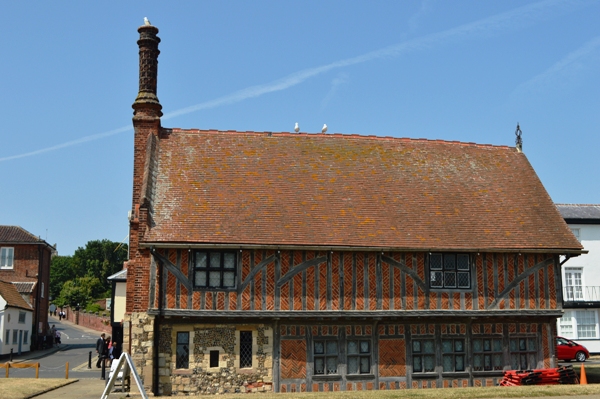
It was a story that led me to Aldeburgh in the first place. I recently read Scapegallows by Carol Birch, a book that follows the life of Margaret Catchpole, a feisty young lady who was twice sentenced to hang and eventually shipped off to Australia. Her true-life account is told in the context of the ‘free trade’ activities (smuggling) that were rife along the Suffolk coast in the late 18th century. The author’s colourful descriptions of the towns and villages along the Orwell and Alde rivers made me curious to see the places for myself. Not for the first time a good story did far more to entice me than any marketing campaign could do.
Having arrived at Aldeburgh I climbed the steps to the Moot Hall, the 15th century timber building that still serves as the meeting place for the Town Council today. I entered the town’s museum and was greeted by a rather excitable elderly lady, who told me with great enthusiasm that I was the first visitor that day. I guess 25 deg C and sunny is a rare turn of events on the east coast and most folks didn’t want to be stuck indoors.
The lady began telling me about the history of the building and how, although it now sits on the shore, it had once been in the centre of the town; such has been the action of the North Sea in slowly but relentlessly claiming the town’s low-lying land. She urged me to go south to Slaughden, where an entire village had been washed away in the Great Storm of 1953 – an enormous event that made an indelible mark on so many communities along this coast.
When I told the lady of my own reason for venturing out to Aldeburgh her face lit up and she told me to go to the local bookshop and request a copy of a book about the town’s smugglers. She described how those caught would be led ‘up the steps’ and tried in the room in which we were standing, with further hearings – and sentences of hanging – taking place in Ipswich.
I took a few moments to look around what is an excellent little museum, but it was the lady’s passion and obvious pride in the town’s history that had me convinced I wanted to come back to Aldeburgh and to learn more about its past.
Just up the coast in Southwold I stood on Gun Hill and looked out beyond the six large cannons and down the row of colourful beach huts below. The guns were never placed here as a defensive measure, but merely as a rather fancy piece of coastal landscaping – it’s said that they were only fired once in 1850 and a man was killed as a result of the explosion.
As I was standing alone reading about the history of Gun Hill, a man came up to me and said, “I see you’re interested in our local history”. For the next few minutes he told me tales of the battles in the North Sea between the English and the Dutch, before surprising me with the account of Rudolf Diesel, the German inventor of the diesel engine, who went missing in the North Sea in rather remarkable circumstances (well worth a read). As suddenly as he had arrived, the man thanked me for listening, wished me a good day and walked on.
Two ordinary people linked by nothing more than a lively curiosity in their local history. And they are not alone – I’ve had similar encounters in many other parts of the country. By sharing their knowledge with a passing stranger they do a great job in promoting their home towns as places to which I certainly plan to return.
I’m sure I’m not alone in being influenced by such encounters. On an individual level they are far more persuasive in creating a positive vibe about a place than any expensive promotion. Should that enthusiasm to share local trivia and history be bottled by local tourism officials and used to encourage others to come and visit? Maybe I’m being selfish, but I suspect things are best left just as they are.




